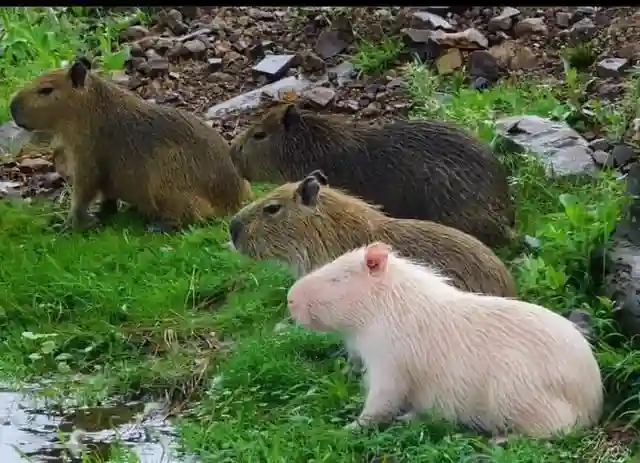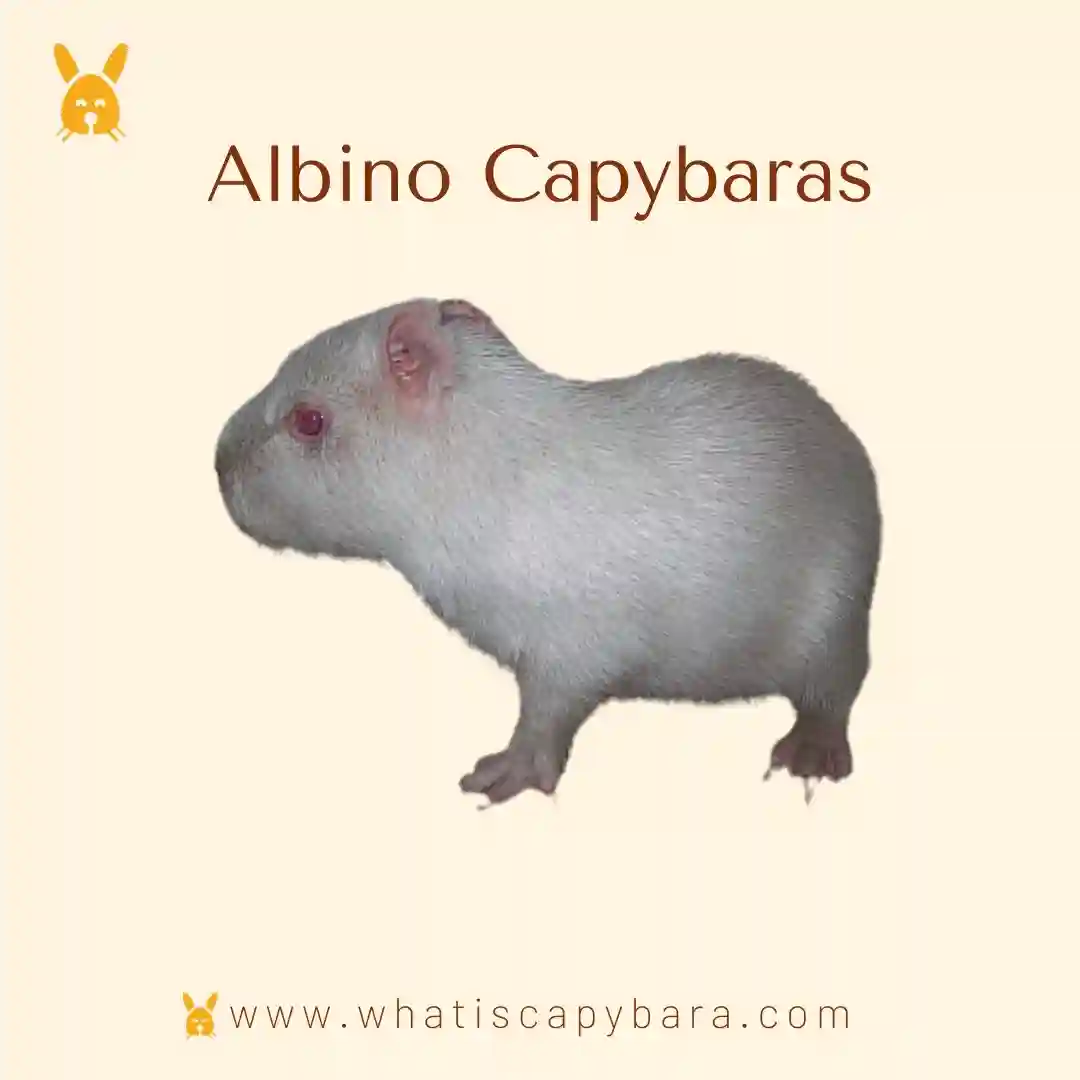I already have capybaras, and I thought of owning an albino capybara, Yes there are albino capybaras also.
I know you must be shocked, but let me tell you there are albino capybaras, of course, they are rare and not seen easily.
Albino capybaras are genetically mutated capybaras, owing to their low melanin amount, Albino Capybaras are unique and rare capybaras.
Hi, I’m Harry, a capybara owner and breeder for the past 5 years, and in this guide, I’ll tell you all about albino capybaras.
Contents
- 1 What Is Albino Capybara?
- 2 What is Albinism?
- 3 How Albino Capybara Look Like
- 4 What Makes Albino Capybara White
- 5 Risk and Challenges of Breeding Albino Capybaras
- 6 Health Conditions in Albino Capybaras
- 7 How to Take Care of Albino Capybaras
- 8 Lifespan of Albino Capybaras:-
- 9 Albino Capybaras Cost
- 10 Albino Capybaras Facts
- 11 How to Get to Albino Capybara
- 12 How many Albino Capybaras are there?
- 13 Are Albino Capybaras Friendly?
- 14 Living Conditions for Albino Capybaras:-
- 15 To Summarize
What Is Albino Capybara?
An albino capybara is a rare capybara with a genetic condition due to which they lose their natural brown pigmentation, making them white.
Their bodies are not able to produce melanin which is responsible for coloration in any living being, which makes them look white.
Albino capybaras are very rare and barely seen in the wild. I had one albino capybara 3 years back, he was very cute. The behavior, nature, diet, and other things are the same it’s just the color that makes them look different.
What is Albinism?
Albinism is a mutational disorder so even the parents do not carry the traits the child might do. In species with albinism stigmatism, low eyesight, and near-sightedness due to lack of melanin in the eye are prevalent.
And, the list doesn’t end here as pet albino capybaras also suffer critical fluctuations in thermoregulation due to low carotenoids in their body. Albinism is a recessive trait.
How Albino Capybara Look Like
Albino capybaras are blessed with a chunky body and of course a unique and pinkish fur coat. These pink-eyed rodents can captivate anyone with their charm. Albino capybaras and non-albino capybaras have almost the same appearance.
As a capybara owner, I can explain what it means for a capybara to be albino. Here are the key points:
- Albino capybaras have a genetic condition that results in the absence of melanin, a pigment responsible for coloration in the skin, fur, and eyes.
- Due to the lack of melanin, albino capybaras exhibit distinct physical traits, including:
- White or pale-colored fur that lacks the usual brown or gray tones.
- Pink or red eyes due to the transparency of the iris, which allows the blood vessels to show through.
- Light-colored skin that may appear translucent or pale.
- The absence of melanin in albino capybaras makes them more susceptible to sunburn and eye sensitivity.
- It is important to provide proper protection from sunlight, including shade and sunblock, to ensure their well-being.
Are Capybaras Dangerous – Do Capybaras Bite
Understanding these characteristics of albino capybaras helps capybara owners provide appropriate care and create a suitable environment for their unique needs.

What Makes Albino Capybara White
As an owner of an albino capybara, I understand the genetic basis of albinism in these fascinating creatures. Here is some information about the inheritance patterns in reference to heterozygous albino capybaras:
- Albino capybaras inherit the albinism trait through a recessive gene.
- The gene responsible for albinism is designated as a homozygous recessive gene (aa).
- Heterozygous albino capybaras (Aa) carry one copy of the albino gene and one normal gene.
- When two heterozygous albino capybaras mate, there is a 25% chance of producing albino offspring (aa), a 50% chance of producing heterozygous albino offspring (Aa), and a 25% chance of producing non-albino offspring (AA).
- Heterozygous albino capybaras can pass on the albino gene to their offspring without showing albinism themselves.
- To produce albino capybaras, both parents must carry the recessive gene for albinism.
Understanding the genetic basis of albinism in capybaras helps in responsible breeding practices and prevents the accidental production of albino offspring.
It is important to consult with experts or breeders knowledgeable about capybara genetics to ensure the well-being and conservation of these unique albino capybaras
Why does Albino Capybara Look, Pinkish White?
There are two explanations for that. Firstly due to their light colorations their skin full of blood capillaries gets exposed making them appear pinkish.
And, secondly, the small left-out carotenoids in their skin that have a reddish pigmentation create the same impact too. Albino capybaras might have some carotenoids even if they completely lack melanin.
Risk and Challenges of Breeding Albino Capybaras
Breeding albino capybaras comes with potential risks and challenges that should be carefully considered:
- Genetic Considerations:
- Albino capybaras have a recessive gene, and breeding two albino individuals can result in a higher likelihood of producing albino offspring.
- Inbreeding may lead to a higher prevalence of genetic disorders or health issues in the offspring.
- Sensitivity to Light and Sun:
- Albino capybaras lack melanin, making them more sensitive to sunlight and prone to sunburns and eye damage.
- Extra precautions and shade provisions are necessary to protect them from harmful UV radiation.
- Health Concerns:
- Albino capybaras may be more susceptible to various health conditions, such as vision impairments, skin issues, and weakened immune systems.
- Special attention and regular veterinary check-ups are crucial to monitor their overall health.
- Ethical Considerations:
- Breeding albino capybaras solely for their unique appearance without considering their specific needs and potential challenges is ethically questionable.
- Responsible breeding practices prioritize the well-being and genetic diversity of the capybara population.
Understanding and addressing these risks and challenges is essential to ensure the welfare and long-term health of albino capybaras.
It is advisable to consult with experts and breeders experienced in handling albino capybaras for proper guidance.
Health Conditions in Albino Capybaras
Albino capybaras are similar to average capybaras in health conditions as well. However, many health conditions in them root out from their albinism.
Because of albinism, albino capybaras have other impaired senses as well. Health issues in Albino Capybaras are
- Sunburn:
- The lack of coloration on albino capybaras makes them susceptible to sunburn.
- As they lack their natural sunscreen which makes UV radiation penetration much easier.
- Eye Conditions:
- Albino capybara (Hydrochoerus hydrochaeris) may suffer from eye-related health concerns such as photophobia.
- It refers to sensitivity to light and a higher level of glare and the reason for that could be their melanin-lacking eyes.
- There are many other eye-related issues that an albino capybara has tendencies of developing like eye infections, and permanent visual impairment.
- They have pinkish-white eyes right from the time they are born.
- Increased Risk of Predation:
- Unlike their colored buddies white-coat capybaras are prone to predators due to their inability to camouflage.
- It also becomes hard for an albino capybara to escape or predict possible danger due to their partial visual impairments.
- Pain sensitivity:
- Due to transparent hairs all over the body the milk capybaras are more sensitive to heat and pain.
- Their ears and nose also have white fur.
- Bone Deformities:
- Going by the sources, Albino capybaras are vitamin D deficient making their bones brittle.
- Capybara albinos should be provided with proper sunbathing to minimize their risk of developing any bone-related issues.
How to Take Care of Albino Capybaras
As a proud owner of an albino capybara, I understand the importance of providing specific care for these unique creatures. Here are some key considerations:
- Temperature Regulation:
- Maintain an ambient temperature between 20-24°C (68-75°F) to prevent overheating or cold stress.
- Offer a temperature-controlled enclosure or access to both shaded and heated areas.
- Sun Protection:
- Protect their sensitive skin and eyes from harmful UV rays by providing ample shade.
- Apply pet-safe sunscreen to exposed areas when necessary.
- Eye Health:
- Be vigilant for signs of eye irritation or infections, and seek veterinary attention promptly.
- Avoid exposing albino capybaras to excessive bright lights or direct sunlight.
- Suitable Environment:
- Provide a spacious enclosure with access to water for swimming and cooling off.
- Include natural vegetation and hiding spots to mimic their natural habitat.
Remember, albino capybaras require extra care and attention due to their unique characteristics.
Can Your Capybara Get Rabies – 6 Symptoms, Prevention, Treatment
Ensuring a suitable environment that meets their specific needs is crucial for their well-being and overall health.

Lifespan of Albino Capybaras:-
Albino capybaras are the rare genetic variation of the species. This semi-aquatic species can live up to 8-10 years in the wild on average.
If kept under captivity provided with proper nutrition, diet, genetics, environment, space, and all other favorable living conditions they may live up to 12 years.
Albino Capybaras Cost
There are websites that lists capybara for sale, but to tell you the rough figure, the price of capybaras ranges from $1500 to $5000. Though it may differ from country to country but not that much.
How Much Does a Capybara Cost – Capybara Price and Other Expenses
As a capybara owner, I understand that the cost of an albino capybara can vary. Due to their rarity and unique appearance, albino capybaras may be more expensive than their regular counterparts.
The price can depend on factors such as breeder reputation, lineage, and demand. It is essential to research reputable breeders and consider associated expenses, such as permits, enclosure setup, and ongoing care when budgeting for an albino capybara.
Capybaras are exotic pets and they will be costly. Also, albino capybaras are rare, but still, albino capybara price is somewhat same.

Albino Capybaras Facts
- Docile:- Albino capybaras are very docile and responsive animals seemingly proving themselves competitive in the petted animals category.
- Born Swimmers:- These cute albino capybaras are naturally good at swimming and are quite active animals for the same reason.
- They have a strong connection with water as it plays an important role in their life cycle at different phases. They are semi-aquatic and bathe to regulate their body temperature.
- Social:- Albino capybaras like their brown buddies are social and cordial in general. They like to live in peer groups of 10-20 for the minimum. It’s recommended for capybara parents to go for two or more capybaras at a time.
- Nocturnal:- Capybaras are in general very active during the night even after not resting the whole day.
How to Get to Albino Capybara
Capybaras in general exist mostly in Central and Southern America. You might find albino capybaras in Venezuela and Uruguay in their natural habitat enjoying swimming with their companion capybaras.
Due to their unique status, they can also be found in Wildlife sanctuaries in Toronto. Furthermore, in Japan, they also exist in parks and zoos exclusive to bred capybaras.
How many Albino Capybaras are there?
Albino capybaras are very rare, so rare that they make up only 1% of the capybara’s population. They struggle to survive in the wilds being left with only a few. Albinism is in itself a pretty rare genetic condition.
The first albino capybara was born out in a breeding station and was named ‘Blancanieves’ or Snow White. Last year a zoo located in Taito Ward, Tokyo on July 10th received its first albino capybara.
Are Albino Capybaras Friendly?
There is no harm in petting these wonderful rodents. They are the largest rodents in the world. Their survival in their natural wild habitat isn’t practical because of the several health conditions they have.
Sources suggest they have been petted since the 18th century. Albino capybaras can be fondled but some necessary boxes of requirements are to be checked first.
Being an exotic species it is a heavily priced pet both in terms of affording and maintaining its lifestyle.
Living Conditions for Albino Capybaras:-
- Sunbathing is a crucial part of their lifestyle. As it is a necessity not a luxury for them. Albino capybaras have vitamin D deficiency and they rest near riverbanks in the daytime to fulfill their sunlight essentials.
- Being the largest rodents in the world, capybaras have a humongous size that demands a big space to fit into.
- Albino capybaras also cannot see in too much glare having eyesight issues. So, give conditions following that to them.
Are there albino capybaras?
Yes, there are albino capybaras but their meager numbers make them seem to be a non-existent species.
Are capybaras stinky?
No, capybaras aren’t a stinky species but they do possess a distinct odor.
Do albino capybaras cry?
Neither albino capybaras nor capybaras, in general, are found crying. The reason for albino capybaras do not cry is the absence of tear ducts in them.
How rare is an albino capybara?
Yes, an albino capybara isn’t a commonly seen species.
Are capybaras friendly?
Yes, capybaras are admiringly pleasant as well as high-spirited species.
How much does an albino capybara cost?
Capybaras are an exquisite species to breed and would cost anything between $1,000-$2,500.
To Summarize
These cute pinkish rodents are in no way different from regular capybaras if we slide apart their appearance and some health anomalies.
Albino capybaras are indeed a wild species but due to their vision impairment, they have a short lifespan. These social animals are highly prone to poaching.
Albino capybaras aren’t petted due to their uncommon status but are kept under surveillance and are one of the most searched animals while sightseeing.
Read more:
Can capybara swim – are capybaras good swimmers
Capybara with other animals – capybara chilling with other animals


This blog was… how do I say it? Relevant!! Finally I’ve found something which helped me. Many thanks!
Hello. Thank you for always good blog구로노래방알바
Hello. Thank you for always good blog신림노래방알바